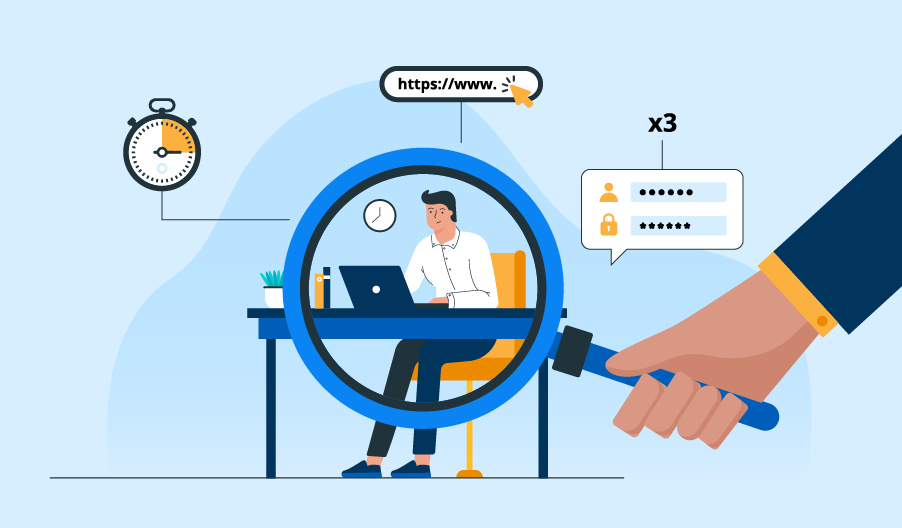Transparency and Communication: Building Trust with Employee Monitoring Software
The advent of remote work and the increasing use of digital communication tools have propelled the adoption of monitoring software to new heights, enabling companies to track productivity, streamline processes, and ensure data security. However, this trend has also sparked concerns regarding employee privacy, autonomy, and the potential for a culture of surveillance.
In this blog post, we delve into the multifaceted realm of employee monitoring software, exploring its promises and pitfalls from the vantage point of transparency and communication.
Read on as we navigate the delicate balance between leveraging such tools to enhance organizational efficiency, respect employees’ rights to privacy and autonomy, and explore the evolving dynamics between employers and employees. Discover how open communication, well-defined policies, and a human-centric approach can not only mitigate the concerns associated with employee monitoring but also cultivate a workplace environment built on trust, collaboration, and shared success.
What is Employee Monitoring Software?
Employee monitoring is the use of computer monitoring to track employee behavior in the workplace. In fact, close to 80% of major companies monitor their employees. This type of software can take many forms, including:
- Computer monitoring—tracking employee computer usage, including keystrokes and websites visited.
- Video surveillance—monitor employee activities in the workplace using cameras.
- GPS tracking—looking into employee location with GPS technology.
- Email and chat monitoring—tracking emails and chats of employees to ensure compliance with policies.
Why is transparency important in employee monitoring?
In an era where digital tools can track various aspects of work, transparent communication regarding the implementation, scope, and objectives of monitoring software is paramount. When employees are informed about what data is being collected, how it will be used, and the reasons behind its collection, it reduces apprehension and engenders a sense of ownership.
Transparent monitoring practices not only alleviate concerns about privacy invasion and surveillance but also demonstrate an organization’s commitment to accountability. Employees are more likely to embrace monitoring initiatives when they perceive them as tools for improvement rather than as methods of control. By prioritizing transparency, employers can nurture a culture of open dialogue, allowing both sides to collaborate towards shared goals while respecting individual rights and fostering a positive work environment.
How Can Employers Increase Transparency In Their Monitoring?
Employers must communicate their monitoring policy to employees. They should explain what will be monitored, the reason for monitoring, and how the collected data will be utilized. All employees should have easy access to this data.
In addition, inform employees about the benefits of monitoring, such as increased productivity and safety. This will help them understand the importance of monitoring and its benefits to both employees and employers.
Employers should consider organizing regular employee meetings regarding monitoring practices, and resolve any issues and concerns they may have. They must also provide employees with channels to give feedback and ask about monitoring practices. For tracking work hours seamlessly, especially in remote work setups, using a Windows time tracker can help businesses monitor productivity and ensure accurate time management. It can take the form of an open dialogue with managers or anonymous channels for feedback. Employees who feel comfortable giving feedback can help identify and resolve any problems that may arise as a result of monitoring practices.
Employers may also use monitoring data to coach employees on how to improve their performance. Employees are more likely to use data for improving performance if they understand the monitoring process and its purpose.
Why Is Communication Important in Employee Monitoring?
Clear and consistent communication ensures that employees comprehend the purpose and benefits of monitoring, dispelling misunderstandings and mistrust. Regular updates about data usage and its impact empower employees, fostering a sense of involvement rather than an intrusion.
Moreover, communication channels provide a platform for addressing concerns, adjusting strategies, and adapting to evolving needs, contributing to a harmonious work atmosphere that values collaboration and mutual respect.
Best Practices
If your goal is to create transparent, communicative, and effective employee monitoring practices, consider these tips:
- Provide training: Employers should offer training to employees on how to operate company equipment and systems, so they comply with company policies.
- Update policies regularly: Employers should regularly review and revise monitoring policies to stay compliant with changes to regulations.
- Protect employee privacy: Employers should take measures to ensure their monitoring practices do not violate employees’ right to privacy.
- Be consistent: Employers must ensure that all monitoring practices are implemented consistently. Employers shouldn’t show any favoritism towards specific employees or make them the target.
Final Thoughts
When it comes to employee monitoring software, trust is a fragile yet vital element. Achieving harmony between technological oversight and employee trust hinges on two crucial pillars—transparency and communication.
By openly sharing the purpose, methods, and benefits of monitoring, organizations can assuage concerns and foster a culture of collaboration. Effective communication channels further ensure that employees feel valued, understood, and part of the process, ultimately paving the way for a balanced and trusting work environment.
